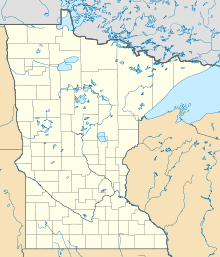Lower Sioux Agency
Coordinates: 44 ° 31 '34 " N , 94 ° 57' 28" W.
Lower Sioux Agency , also Redwood Agency , was the administrative center of the Lower Sioux Indian Reservation in what is now Redwood County , Minnesota . The battle for the Lower Sioux Agency, the first battle of the Sioux uprising, took place here on August 18, 1862 . Today it is a recognized United States Historic Site and is operated by the Minnesota Historical Society . There is an information center and a rebuilt warehouse from 1861.
history
The Lower Sioux Agency was established in 1853 by the United States government as the administrative center of the newly created Lower Sioux Reservation. Mdewakanton and Wahpekute Indians of the Santee , Dakota and Sioux populated the reservation, which was established after the Treaty of Mendota on August 5, 1851. In this contract, the Indians sold areas in southern Minnesota to the federal government for 1.4 million dollars and withdrew to the reservation area. The funds were held in trust by the Bureau of Indian Affairs . The Indians decided to give up their nomadic life as hunters and to become sedentary farmers. Furthermore, the contract consisted of obligations for the delivery of food and other equipment to the settling Indians. The Lower Sioux Agency was founded to manage the funds and set up schools.
The Indian reservation was further reduced in 1858 when Minnesota was admitted as a state to the United States. Their territory no longer offered enough space for the Indians to fend for themselves, leaving them completely dependent on government payments and white traders. Government payments, on the other hand, have always suffered greatly from corruption in the Bureau of Indian Affairs. In 1861 the situation of the Indians worsened. A bad harvest forced them to buy food on credit from the vendors and go into debt. In 1862, payments by the US government were also delayed due to the Civil War (Washington was unsure whether the annual payments should be paid in gold or with the new greenbacks .
On August 15, 1862, the residents of the reserve asked the white traders to distribute food. Since the funds had not yet arrived from Washington, Indian agent Thomas J. Galbraith refused to hand over food from the agency's warehouse. In a meeting with the trader Andrew Myrick , the Indians demanded that food be sold on credit. Myrick said, “In my opinion, you should eat grass or your own excrement when you are hungry.” Other agencies did different things. In the Upper Sioux Agency , the agents responsible had given out food to the starving Indians of the Sissetowan and Wahpeton Dakota, even though they had not yet received any money from Washington.
The payments due to the Indians had arrived in Minnesota's capital St. Paul on August 16, 1862, and were forwarded to Fort Ridgely on August 17 . But the payments came too late. On the same day, four Dakota warriors in search of food murdered five white settlers. A council of war convened after the murder decided to launch further attacks on the white settlements and asked Chief Little Crow to lead them.
On August 18, 1862, Indians led by Little Crow stormed the Lower Sioux Agency. Andrew Myrick tried to escape by climbing through a window on the second floor of the agency's warehouse. He was later found dead with grass in his mouth. The Indians burned the agency down. Much of the whites escaped by ferry across the Minnesota River. Alarmed units from B Company of the 5th Minnesota Volunteer Infantry Regiment, a Minnesota state militia led by Captain John Marsh, rushed to the rescue but were defeated by the Indians in the Battle of Redwood Ferry. 24 militiamen died, including their leader. In the course of the day several white settlements in the Minnesota Valley were burned down and most of the inhabitants were killed.
Only the stone warehouse survived the attack unscathed. Today there is a park on the site, with guided trails and an information center. The museum is located on the grounds of the Lower Sioux Agency Indian reservation that still exists today.
Web links
- Side of the Minnesota Historical Society (English)
- Side of the Lower Sioux Indian Community (English)
- Sioux War of 1862 (English)
Individual evidence
- ^ Alvin M. Josephy: The Civil War in the American West. Knopf, New York 1991, p. 107.)
- ^ Richard H. Dillon: North American Indian Wars . Booksales, City 1920, p. 126.
- ↑ Andrew Myrick: "So far as I am concerned, if they are hungry let them eat grass or their own dung."
- ↑ August 18, 1862 - Beginning of the Sioux Uprising (or Santee War) in Minnesota
- ^ Most settlers in the Minnesota River Valley had no experience with warring Indians. Those who did not flee to a fort or defended settlement fast enough were at the Indians' mercy. The Sioux killed most of the settlers they encountered but often made captives of the women and children



